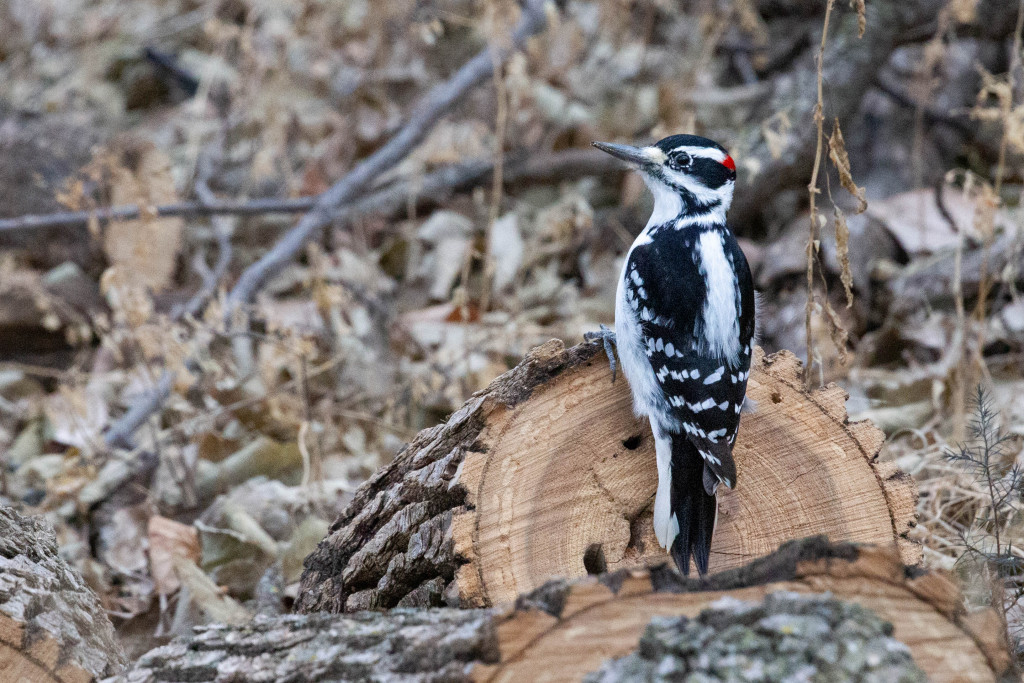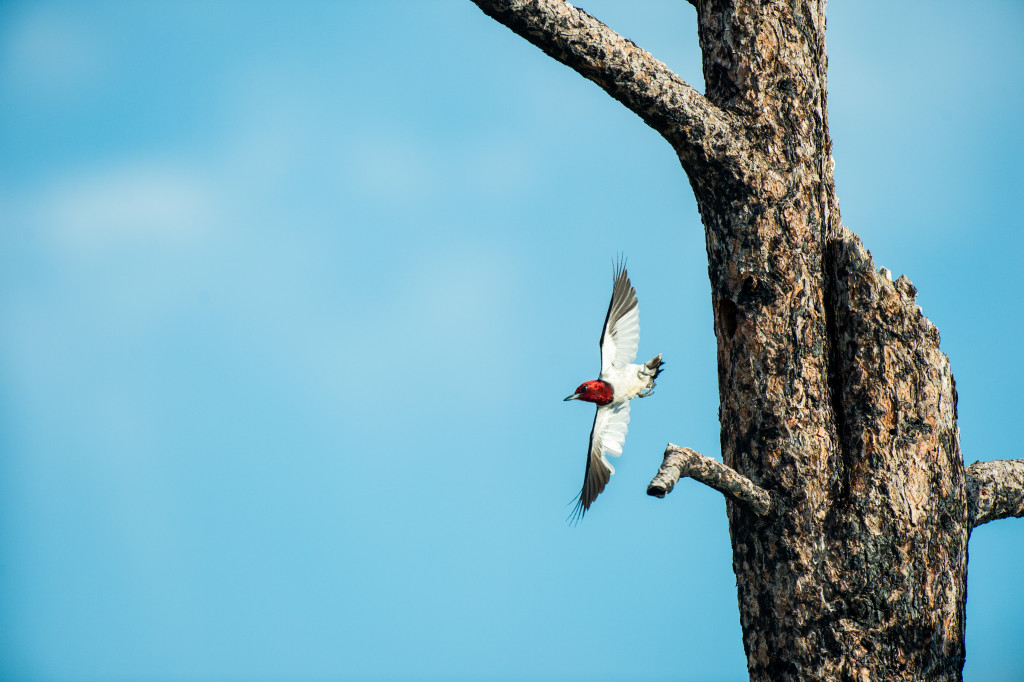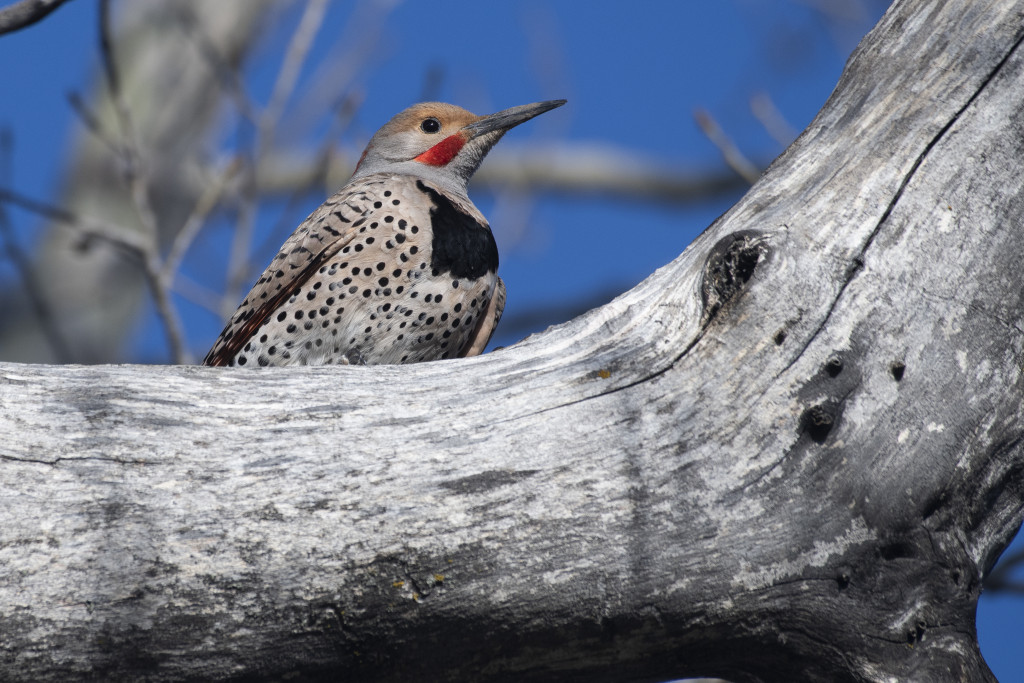By Amber Schiltz
Woodpeckers are special birds known for exactly what their name describes — “pecking” at wood. Using their strong beaks to drill into living or dead trees helps them look for tasty bugs, build cozy nests for their young, and even allows them to talk to one another by the the sound of their drilling. Woodpeckers have incredible adaptations, or tricks, to help them drill. This includes a stiff tail that keeps them from falling as they drill and a tongue so long that— when not being used to catch bugs — wraps around the woodpecker’s brain to cushion the impact of drilling. Nebraska is home to several types of woodpeckers. Let’s learn more about five of the more common woodpeckers you might see in Nebraska and how to find them.
Downy Woodpecker
Downy woodpeckers are the smallest of Nebraska’s woodpeckers and are found year-round throughout the state.

Description
- 5-6 inches long, beak is half the length of head
- Black and white checkered pattern over back, white belly
- Males have small red patch on back head
Diet
- Insects, beetle larvae, ants, caterpillars
- Seeds, nuts, and berries
Habitat
- Open, woody forests; neighborhoods and parks with plenty of trees
Fun Fact
- You can spot a downy woodpecker by the way it rises and falls as it flies, like an acrobat in the air!
Hairy Woodpecker
Hairy woodpeckers look like downy woodpeckers, only with bigger bodies and beaks. They’re found year-round throughout Nebraska, but are more common in the eastern part of the state.

Description
- 7 inches long, bigger beak (full length of head)
- Black and white checkered pattern over back, white belly
- Males have a small red patch on the back of their head
Diet
- Beetles, beetle larvae, other insects
- Seeds, nuts, berries
Habitat
- Woody forests with bigger, older trees
- Need big dead trees to nest in
Fun Facts
- Sometimes drink up tree sap left behind by their woodpecker cousin the sapsuckers!
Red-headed Woodpecker
The striking red-headed woodpecker can be found throughout Nebraska during the warmer months of spring, summer, and fall.

Description
- 7-9 inches long
- Black and white stripes on back, white belly
- Adults have bright red feathers covering entire head and shoulders
Diet
- Insects, beetle larvae, and flying insects (catching them right out of the air, unlike other woodpeckers!)
- Seeds, nuts, and berries
Habitat
- Scattered open, woody forests with dead trees near open areas and wetlands
Fun Fact
- Red-headed woodpecker fossils believed to be over 2 million years old were discovered in eastern United states!
Red-bellied Woodpeckers
Red-bellied woodpeckers are commonly found year-round throughout central and eastern Nebraska.

Description
- 9 inches long
- Thin black and white stripes on back, pale whitish-yellow belly
- Adults have a red streak of feathers from their beak over their head to their back
Diet
- Insects, spiders, beetles
- Acorns, nuts, pine cones, and flower seeds
Habitat
- Forests, woodlands and neighborhoods with lots of trees
Fun Fact
- A pair of red-bellied woodpeckers often nest in the same tree year after year
Yellow-bellied Sapsucker
Yellow-bellied Sapsuckers are found migrating through eastern and central Nebraska in spring and fall.
Description
- 7-8 inches long
- Mostly black and white with big stripes on face, white to pale yellow belly
- Both adults have red foreheads, males also have red throat
Diet
- Tree sap! Sapsuckers drill trees like other woodpeckers, but instead of drilling for bugs, they’re after sweet tasty sap!
- Ants, spiders and other insects
Habitat
- Forests and woody areas with many young, fast growing trees
Fun Fact
- The sap-wells or holes these woodpeckers create in trees attract other animals wanting a sweet taste of sap – including hummingbirds, bats, and porcupines!
Northern Flicker
Northern flickers are found year-round throughout Nebraska.

Description
- ~12 inches long
- Brownish and greyish over most of body, black spots, stripes and shapes across belly and back
- Yellow, orange to red colors under their wing and tail
Diet
- Ants, beetles, and other insects they catch by flicking through leaves and grass and pecking at the dirt on the ground
- Seeds, berries, and nuts
Habitat
- Open habitats near trees, forests, neighborhoods and parks
Fun Fact
- Flickers use their special barbed tongue to catch and eat their favorite food – ants!
For more information and to discover more woodpeckers and birds that call Nebraska home, visit the Birds of Nebraska library here.
